Contents
Author Brad Lane lived in Missoula, Montana for nearly three years and explored the state extensively.
From massive reservoirs to glacier-carved bodies of water, Montana’s lakes represent the rugged and wild nature of the state. Many of the best lakes in Montana are in the mountainous western half of the state near principal cities like Missoula, Bozeman, and Helena. Although the largest lake in Montana, Fort Peck Lake, is in the eastern part of the state.
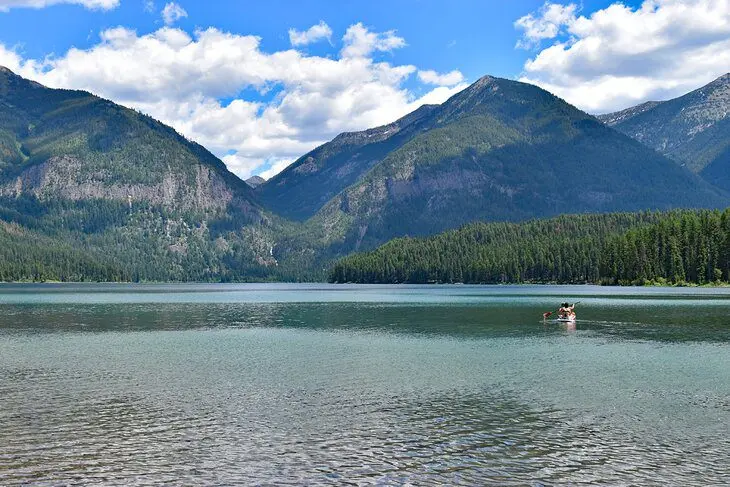
Lakes that showcase the scenic beauty of western Montana include Flathead Lake, Whitefish Lake, and Seeley Lake. These vacation lake destinations feature campgrounds, lodging, restaurants, and boat rentals close to the shore. More rustic but easily accessible lakes in western Montana include Holland Lake, Dickey Lake, and Browns Lake.
The Crown of the Continent in northern Montana, Glacier National Park, also has some of the best lakes to explore. Amazing lakes at Glacier include Lake McDonald on the west side and St. Mary Lake on the east side. Another notable lake in Glacier National Park is the hike-in-only Avalanche Lake.
Popular activities on the lakes including boating, fishing, swimming, and appreciating the scenic beauty of the state. For more ideas on where to go for a day by the water, see our list of the best lakes in Montana.
1. Flathead Lake
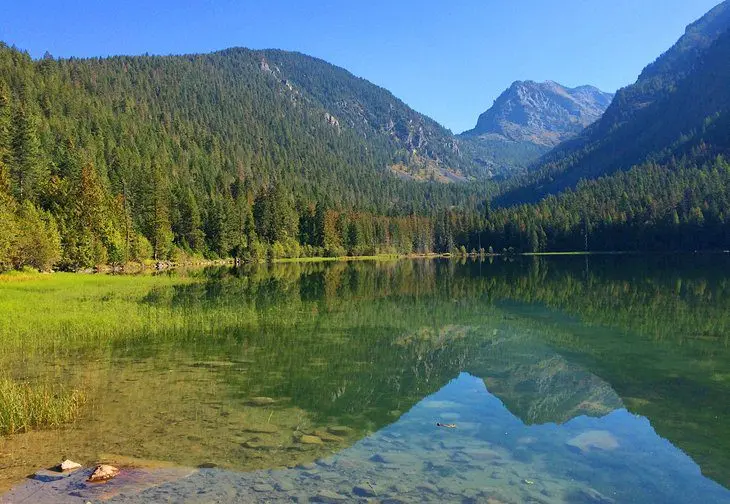
The largest natural lake by surface area west of the Mississippi River, the area around Flathead Lake offers visitors numerous things to do. The clear water of Flathead Lake is accessible from either Highway 93 or Highway 35. Both highways connect and circle the entire body of water. Several public access points line the shore of Flathead Lake, including six units of Flathead Lake State Park. Some of the best campgrounds in Montana are also found close to the shore.
All types of boating are welcome on Flathead Lake. Communities including Bigfork and Polson also line the shore with restaurants, lodging, and marinas. The Bigfork Mountain Lake Lodge is a notable place to stay on Flathead Lake. Alongside rooms near the water, Mountain Lake Lodge features stunning sunsets and views of the Mission Mountains.
During spring and early summer, the orchards surrounding Flathead Lake provide delicious U-pick opportunities for Flathead cherries. The unique Wild Horse Island State Park is the lake’s largest island and is a favorite spot for hikers and wildlife enthusiasts. Traveling from the nearest big city in Montana, it’s just over an hour’s drive from Missoula to Flathead Lake.
Near Flathead Lake’s northeastern shore, Swan Lake is another popular body of water for outdoor recreation. Camping is popular at the adjacent Swan Lake Campground. Another lake close to Flathead Lake, Echo Lake, is also on the northeast shore and is popular for its warmer water.
2. Whitefish Lake
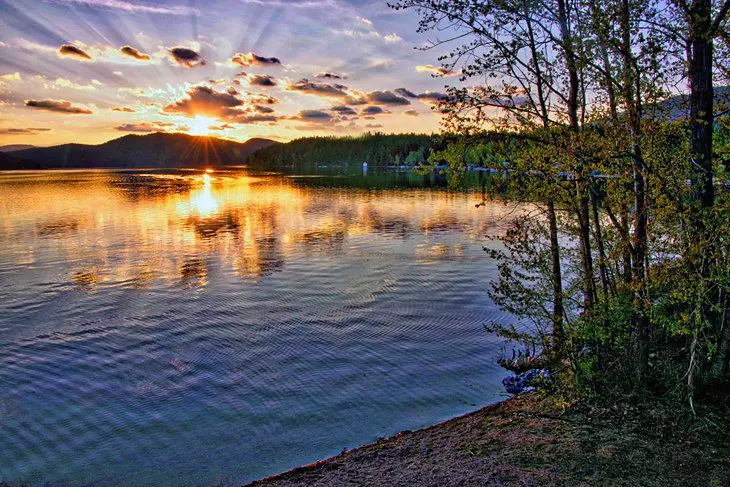
Whitefish Lake is near the ski slopes of Whitefish Mountain Resort and adds another reason to visit the city of Whitefish in northern Montana. Covering approximately 5.2 square miles, the lake is popular for fishing, boating, and swimming. Cannonball enthusiasts beware, though, this glacially carved lake remains shockingly cold throughout most of the year.
On the southwest shore, Whitefish Lake State Park has a boat ramp, boat rentals, and campsites to spend the night. Whitefish City Beach is also on the south shore of the lake and is one of the most popular spots to go swimming in the summer. The Lodge at Whitefish Lake is one of the best lake resorts in the region and features historic Western charm and stunning views of the water.
3. St. Mary Lake
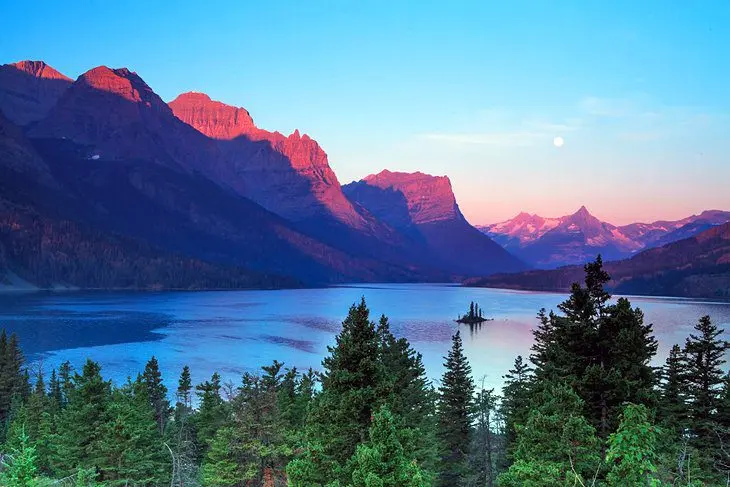
The views while driving along the 10-mile-long St. Mary Lake in Glacier National Park are a defining sight of many visits to the park. At the base of dramatic mountain peaks, the forested area surrounding the lake is a prime habitat for wildlife like elk, bighorn sheep, and bears. Wildflowers bloom throughout the park in the warmer months and add an extra scenic appeal to St. Mary Lake.
Guided boat cruises are available across St. Mary Lake throughout the summer. The nearby St. Mary Visitor Center offers information about the park and a place to pick up the free Going-to-the-Sun Road Shuttle. Several hiking trails also explore the area, and two of the best campgrounds in Glacier are located near the shore.
St. Mary Lake is the second largest lake in Glacier National Park. Its western counterpart, Lake McDonald, has even more surface area and a pebbly shore to explore. One of the most popular lakes to hike to in Glacier, Avalanche Lake, is accessible with a 4.5-mile round-trip hike.
- Read More: Top-Rated Things to Do in Glacier National Park, MT
4. Seeley Lake
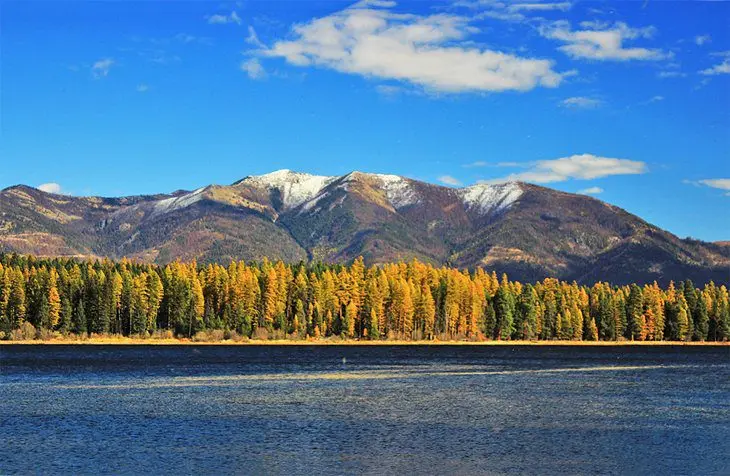
Seeley Lake is an hour’s drive from Missoula in western Montana, framed by the dramatic mountain ranges of the Seeley-Swan Valley. The lake encompasses over 1,000 acres and is adjacent to the sprawling Bob Marshall Wilderness. The entire community of Seeley Lake is also a gateway to Glacier National Park. But, Seeley Lake is a destination itself, and a popular spot for boating, fishing, and taking in the scenic shoreline.
Seeley Lake has public boat ramps and boat rentals, as well as several great places to stay near the water. The forest service operates three different campgrounds near the shore. The Seeley Lake Campground features a beach, swimming area, and 29 campsites. Great lodging options exist on Seeley Lake at places like Seeley Lake Lodge and The Lodges on Seeley Lake .
Seeley Lake is one of a dozen in a chain of lakes within the Clearwater River Valley. Other bodies of water in the Clearwater Chain of Lakes include Rainy Lake, Placid Lake, and Salmon Lake. These lakes are also popular for boating, water sports, and fishing, and each has a campground. Many of these lakes are accessible via Highway 83. Others like Clearwater Lake require travel on forest roads.
5. Holland Lake
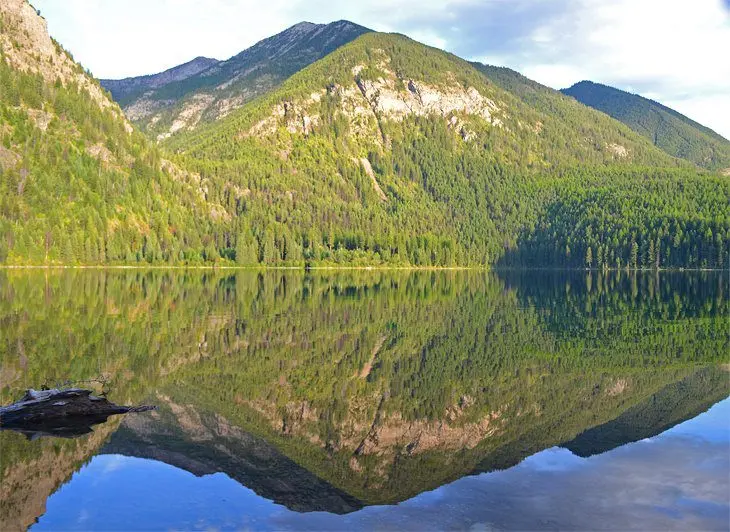
Holland Lake is a stunning alpine body of water North of Seeley Lake on Highway 83, within Flathead National Forest. The Forest Service offers a day-use area at Flathead Lake and a popular campground to spend the night. One of the best hiking trails in Montana traverses near the shore of the lake to reveal the spray of Holland Falls.
Boating is popular on the approximately 400-acre lake, and the surrounding Swan Mountains add scenic appeal to activities like kayaking, water-skiing, and getting atop the water. Fishing for salmon and trout is also popular at Seeley Lake, particularly on the weekdays when there is less boat traffic.
A popular place to stay and host big events including weddings, Holland Lake Lodge is on the north shore of the lake.
6. Fort Peck Lake
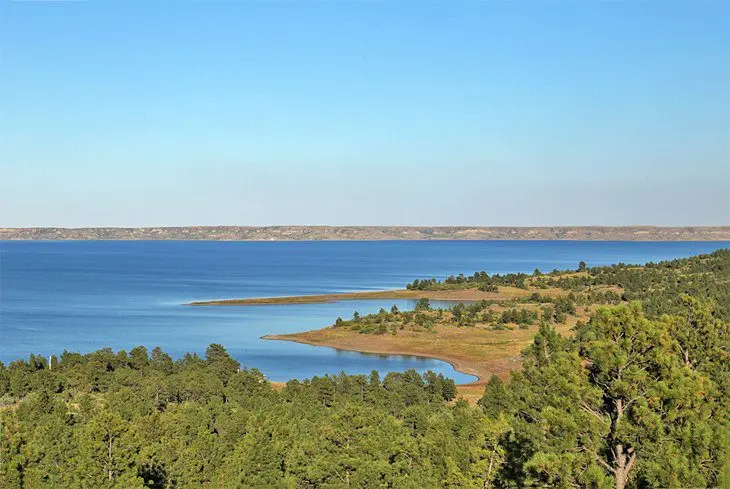
Created by an impoundment of the Missouri River in eastern Montana, Fort Peck Lake is the largest lake in Montana. This massive man-made reservoir is approximately 134 miles long with over 1,500 miles of shoreline.
Fort Peck Lake is popular for many activities, including boating, swimming, and especially fishing. A popular place to access the water is the Fort Peck Marina located just west of the Fort Peck Dam.
Surrounding the lake is the expansive Charles M. Russell National Wildlife Refuge. Many opportunities to hike, camp, and explore this designated wildlife refuge exist throughout the complex.
7. Avalanche Lake
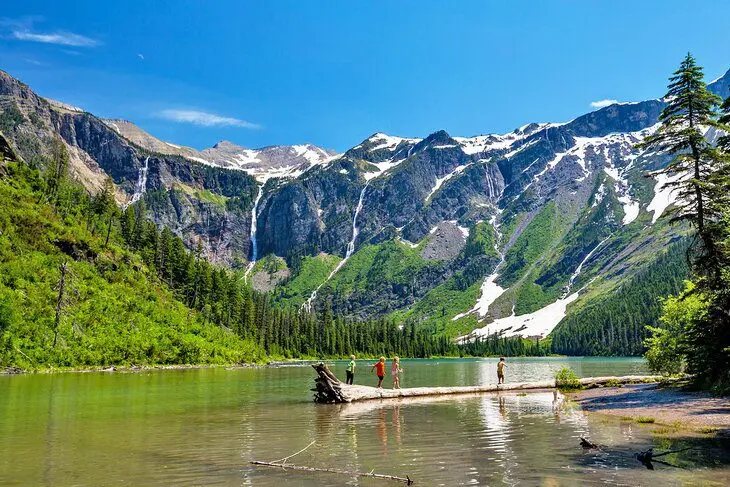
Avalanche Lake is a popular body of water in Glacier National Park that is only accessible by hiking trail.
It’s a five- to six-mile round trip to the lake and back, depending on where on the shoreline visitors turn around, with less than 600 feet of elevation gain. While this is a moderate distance, it makes the lake route one of the easiest to hike to in the park.
The upright mountain peaks at the back end of the lake also make this a picture-perfect representation of Glacier’s massive landscapes. Several impromptu hangout spots line the west shoreline, offering excellent places to rest and enjoy the alpine landscape before heading back to the trailhead.
Avalanche Lake is mostly a spectating experience, but the dramatic mountain scene delivers. The water is icy cold, and on hot enough days, it’s perfect for a quick dip.
8. Dickey Lake
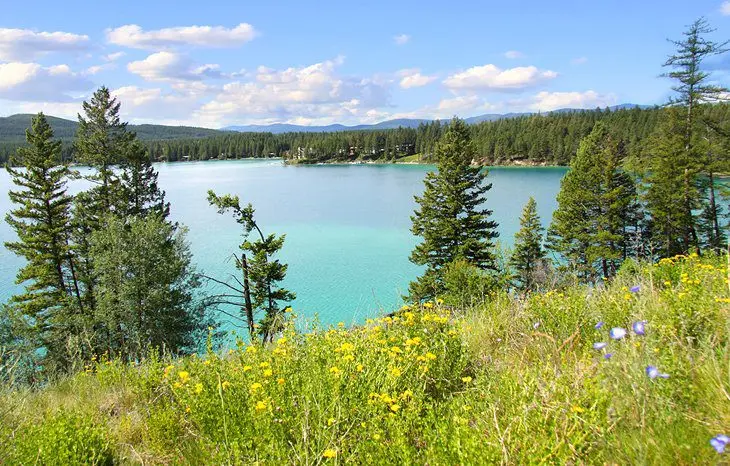
A lush forest of larch and fir trees surrounds this 800-acre lake within Kootenai National Forest in northwest Montana. It’s easily accessible from Highway 93 and is popular for boating, swimming, and fishing for salmon and trout. It’s also a destination for shoreline activities like camping and hiking.
The North Dickey Lake Campground features 23 sites for tent and RV camping. A day-use area with a grassy swimming beach is located on the other side of the lake; swimmers enter the water at their own risk.
9. Browns Lake

Browns Lake is a popular fishing lake in the middle of the Blackfoot River watershed. This 550-square-acre lake is most easily reached from the small community of Ovando in western Montana.
The U.S. Fish and Wildlife Service maintains public access on the eastern shore. Facilities include a boat ramp, restrooms, and a small campground that can accommodate trailers. A variety of trout is in the water of Browns Lake, including gigantic rainbow trout.
10. Tally Lake
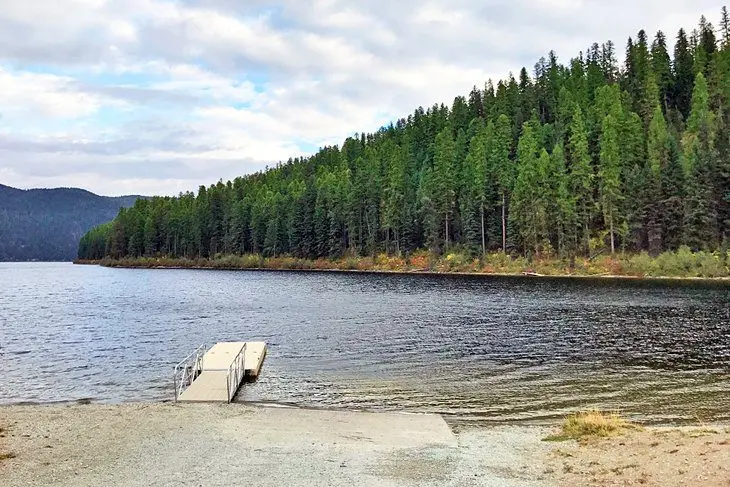
West of Whitefish in Flathead National Forest, Tally Lake is the deepest natural lake in Montana. With depths as far down as 445 feet, Tally Lake is also surrounded by mountainsides covered in trees.
Popular activities at Tally Lake include boating, fishing, and hiking the many trails. The forest service operates the Tally Lake Campground, which features a public boat ramp and shoreline picnic area. The water remains frigid throughout the year, but feels nice on a hot summer day.
11. Hebgen Lake

In southwest Montana near West Yellowstone, Hebgen Lake is a two-hour drive from Bozeman and has a long history as a resort and vacation destination, although a devastating 1959 earthquake damaged many homes in the area.
This man-made lake has bounced back with tourist traffic ever since. Today, Hebgen Lake is an outdoor playground for boaters, skiers, swimmers, and those looking to catch some fish.
Access to various fishing sites lines the relatively small shore of Hebgen Lake. The forest service also operates several campgrounds in the region. Marinas dot the shoreline and offer boat rentals, including canoes, kayaks, and stand up paddleboards. Five miles north of Hebgen Lake, Quake Lake offers a chance to see the longstanding effects of the 1959 earthquake.
12. Canyon Ferry Lake
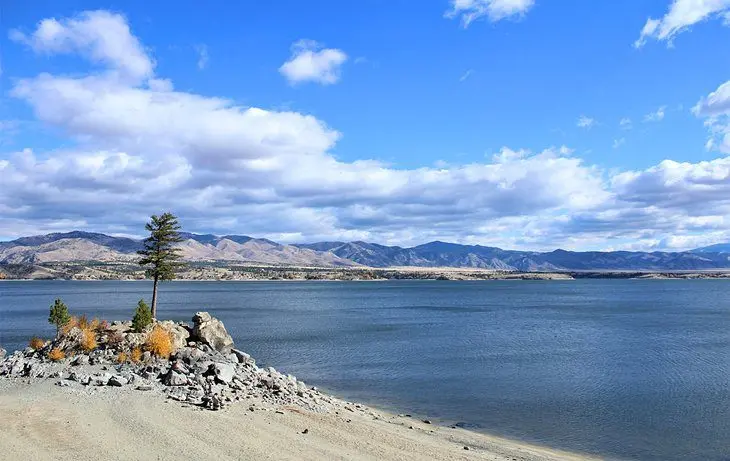
Canyon Ferry Lake is a massive reservoir on the Missouri River and a popular recreation destination. Some of Canyon Ferry Lake’s popularity is due to a location approximately 20 miles east of the state capital of Helena. Canyon Ferry Lake is also popular for its sheer size covering 35,000-square acres. Common activities at the lake include hiking, camping, boating, and fishing for trout and walleye.
Several recreation sites operated by the Bureau of Reclamation surround the shores of Canyon Ferry Lake. These sites include picnic areas, boat ramps, swimming beaches, and campgrounds that support tent and RV camping. Three marinas are also available at Canyon Ferry Lake with boat rentals, gasoline, and groceries.
13. Lake Koocanusa
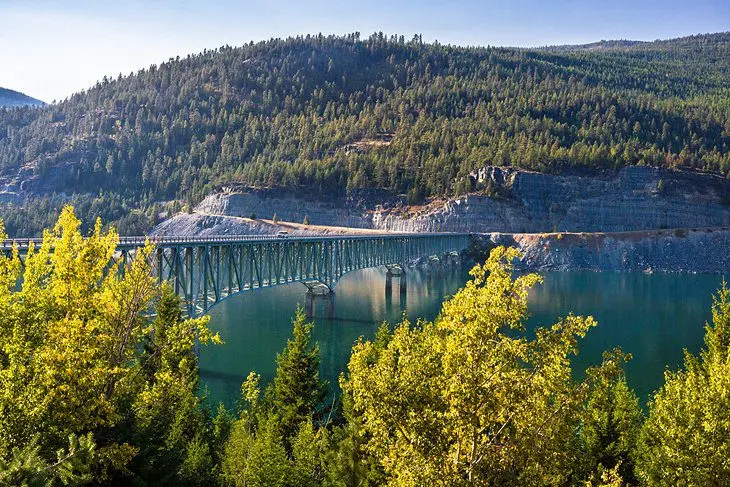
This massive reservoir extends for 90 miles in the far northwest corner of Montana, into British Columbia. Highway 37 extends along the entire U.S. eastern shore of the lake and provides several opportunities to enjoy the water.
Boat ramps, campgrounds, and day-use areas at Lake Koocanusa lend to popular activities like water sports, fishing, and pitching a tent. Tours of the Libby Dam are also available throughout the summer.
The rugged and remote location of Lake Koocanusa, surrounded by Kootenai National Forest, also makes the area rich with wildlife. Lake Koocanusa receives international visitors, but the waters are still explored mainly by locals. This makes Lake Koocanusa a great place to escape the crowds.
14. Lake Elmo

This 64-acre lake is within Billings, the largest city in Montana, and is surrounded by a state park of its own name. Only non-motorized boats can access Lake Elmo, making the water a popular spot for canoes, kayaks, and swimmers.
Fishing is also popular at Lake Elmo with fishing at Roger’s Pier in the summer and ice fishing in the winter. A paved hiking trail circles the entire lake, and the city’s only dog park is on the western shore.
15. Earthquake Lake
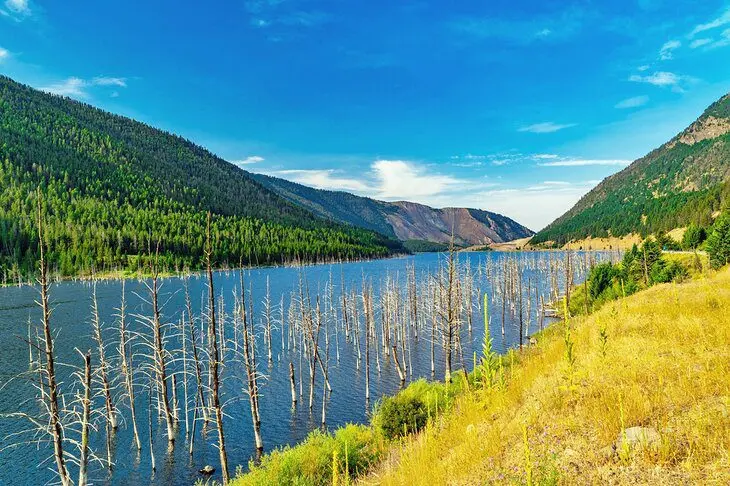
Earthquake Lake, better known as Quake Lake, is the result of a massive landslide into the Madison River in 1959, triggered by a devastating 7.2-magnitude earthquake—still the largest earthquake to shake the state in modern history.
The landslide occurred downriver from Hebgen Lake. The force and sudden change of geography almost instantly flooded National Forest Service facilities, including a campground, and tragically killed at least 28 people.
Today, Quake Lake offers an interesting, if not eerie, side-trip when visiting Hebgen Lake. Or, it can be a unique standalone place to visit. The on-site Earthquake Lake Visitors Center offers narrative storytelling of the disaster and a memorial remembering all the victims of that fateful day.
More Related Articles on PlanetWare.com
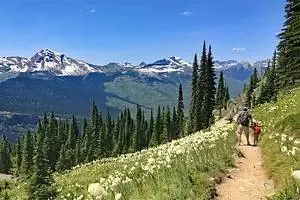
More to Explore in Montana: There’s a lot to explore in Big Sky Country, and the state’s best hiking trails can lead you down some memorable paths. Including lakeside accommodations, the top-rated campgrounds in Montana will have you pitching a tent or parking an RV in other wild places. For the ultimate exploration of the state’s crown jewel, our guide to Glacier National Park can have you wanting to move to Montana in no time.
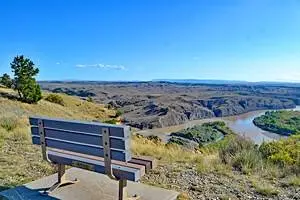
Cities in Montana: The attractions in state capital of Helena are a good first place to start exploring the history and nature of Montana. Also in the western part of the state, the university cities of Bozeman and Missoula offer cultural attractions surrounded by gorgeous mountain settings. Towards the eastern part of the state, the city of Billings is the largest in Montana and offers a wide range of things to do.










